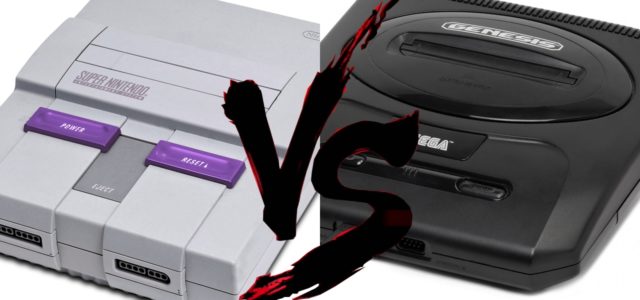Console Wars: SEGA Genesis vs SNES

Decades of video game tribalism, juvenile insults, and schoolyard myths about distant uncles working at certain console manufacturers can be traced back to one provenance: Super Nintendo vs. Sega Genesis. Yes, there were ancient console wars in the ’80s, and today there exists a mild chill between Sony adherents and Microsoft lifers, but the battle was never more ferocious than it was in the mid ’90s, when Sega fielded their Hedgehog against Nintendo’s plumber, and threatened a fight to the death.
Disney decided to throw gasoline on this long-dormant fire on Wednesday, when the company announced they’ll be remastering a pair of the classic platformers: The Lion King and Aladdin, to release fall 2019.
If you are a child of the ’90s, you probably remember endless heated debates about which version of Aladdin was superior (the SNES version isn’t included in the new collection). It was a symptom of the times — back in those days, Nintendo and Sega wouldn’t port the same game to each system. Instead, they often opted to build an entirely different game of the same name, on each platform. Two radically different Aladdins, fighting to be the One True Aladdin. It was like Pokemon Red and Blue — if they spoke different languages and refused to talk to one another.
So to celebrate this brief return of the vintage console wars, we’ve decided to look back at some of the games released on both the Genesis and the Super Nintendo, with minor or major differences.
Aladdin

For my money, Aladdin remains the strangest case of the SNES vs. Genesis software war. Unlike the games in this slideshow that diverge within the forensic analysis of sprite sizes and control fidelity, Disney instead made two distinct, radically different products. Aladdin for the Genesis came out in 1992 and was developed by Virgin. Aladdin for the Super Nintendo arrived a year later, and was put together by Capcom. Philosophically, the Genesis version was more action-focused — Aladdin brandished a scimitar — while Capcom essentially turned Prince Ali into a glorified Mario, with swinging and springing platform mechanics. Perhaps the biggest point of contention is each game’s carpet escape level: The SNES interpretation was hard, but on the Genesis it was absolutely brutal. Like, almost as bad as Battletoads’ legendary Turbo Tunnel. If you’re wondering why I’m traumatized today, it might be because I watched Aladdin get swallowed up by a wave of lava one too many times.
The Lion King

Unlike Aladdin, The Lion King is basically the same game on the Genesis and the Super Nintendo. Meaning: You will die on the “Just Can’t Wait To Be King” level equally. Your preference will come down to your own console tribalism, but there are plenty of people out there who swear by the Genesis version’s music. Take that for what you will.
Scooby-Doo Mystery

Scooby-Doo solves crimes right? Sunsoft took that to heart when they developed the Genesis version, building what’s effectively a point-and-click adventure for console. Argonaut, who made the SNES adaptation, did not get that memo. Like everything else, they turned Scooby-Doo into a platformer with an inventory system.
Earthworm Jim

Maybe it’s the sardonic humor, or the weird fleshy textures, or the off-brand nature of the mascot, but something about Earthworm Jim has always felt more like a Genesis game than a Nintendo game. Doesn’t matter though, because the two versions are nearly identical. Honestly, the big winner is the Sega CD version, which packed more levels, and better animation.
Zombies Ate My Neighbors

You gotta love LucasArts in the early ’90s. Instead of mining Star Wars to death, George Lucas let his developers go wild with one of the most diverse portfolios in gaming. Chief among that weirdness is Zombies Ate My Neighbors — a classic run ‘n gun where two friends take back the cul-de-sac from a parade of horror-movie villains. The SNES came out on top here, with better sound quality, a brighter color palette, and more detailed textures.
Animaniacs

This is a weird one: The Animaniacs games were both developed by Konami, and yet the results completely diverged. The Nintendo version was a brawler in the vein of Double Dragon, with different sprites, different music, and different gameplay. But the Genesis version was more or less a platformer. What happened, Konami? Wouldn’t a straight port be easier?
Street Fighter II Turbo

One of the greatest fighting games of all time is a dead heat on the Super Nintendo and Genesis. Graphically the game looks a little bit better on SNES, but diehards have often leaned towards Sega’s interpretation, just because of the Genesis’ mammoth six face buttons.
NHL 94

Some people don’t even consider NHL ’94 to be a Super Nintendo product. The greatest hockey game ever made has a slew of adherents, and most swear the Genesis version offers better sound and better gameplay than the Nintendo version. I’d weigh in myself, but I’ve learned to never doubt hockey mega-fans.
Mickey Mania

Mickey Mania rules. When I played this as a kid I was stunned by the fidelity — particularly in the ersatz Steamboat Willy level. Leave it to Disney to somehow produce the best animations of the 16-bit era. The Genesis version has a few more flourishes, (cutscenes, and a pair of extra levels,) but seriously, I’ve you’ve never played Mickey Mania, go give it a shot no matter the flavor.
Mortal Kombat

On a pure technical level, the SNES version of Mortal Kombat pushed out more frames of animation than its Genesis contemporary. But if it’s 1992, and you wanted to play the most controversial game in the world, none of that mattered. The Genesis port stands alone, because the Genesis let you punch in the infamous blood code — which reverted the “sweat” effects back to their original red color, ensuring your Thunder God-given right to draw blood when you punched Raiden in the face.
Ys III: Wanderers From Ys

If you wanna see what a 16-bit era downgrade looks like, take a gander at the SNES version of Ys III. On the Genesis you’ll find a vibrant, seductive fantasy world worthy of one of the greatest action role-playing franchises of all time. But on the Super Nintendo, the color has been drained, the sprites are splotchy, and entire cutscenes are missing.
Taz-Mania

On the Genesis, Taz-Mania was a normal, run-of-the-mill platformer — similar to every other licensed adaptation hitting store shelves. On the Super Nintendo though, you could find a much weirder, and arguably much worse, Mode 7 racing game, where Taz runs down an endless stretch of asphalt while trying not to hit passerbys or pools of water. It’s an interesting proof of concept, but trust us, you’re not missing much.
Jurassic Park

Like Aladdin, Jurassic Park is two different games depending on whether you played it on SNES or Genesis. I spent a lot of time with the SNES version growing up, and today it’s remembered as a weird, experimental classic — you walk around a gigantic Zelda-like overworld that switches to a first-person mode whenever you dig into the research base catacombs to do some good old-fashioned, Doom-inspired, dino dungeon crawling. The Genesis served up something completely different — a 2D action platformer that looks something like an extremely prototypical Uncharted. The Genesis version comes out on top though, because it allows you to play as a velociraptor. It’s a fundamental law of physics; 9-year olds want to grow up to be dinosaurs, not scientists.
Sunset Riders

Sunset Riders, the greatest arcade game ever made, is done justice on the Super Nintendo. It essentially works like a full port from what you’d find at your local Chuck E. Cheese, with the usual fidelity downgrades to fit the SNES frame. But something went wrong on the Genesis. Only half the levels from the arcade made it to Sega’s machine, the bonus stages were removed, and only two of the four main characters are featured. That being said, the Genesis does feature a completely original level, that doesn’t appear on either the SNES or Arcade installations. Also, the Genesis lets your character burn to death, with Nintendo pruned thanks to its stringent family-friendly policy back in the early ’90s.
The Adventures of Batman and Robin

A tale of two Batmen. The Caped Crusader was big in the mid-’90s thanks to the immortal animated series, so Konami took a crack at a SNES adaptation, while a studio called Clockwork Tortoise lined up their attempt to bring Gotham City to Genesis. The results are miraculously synchronistic; despite having different color schemes, different levels, different animations, and different storylines, they’re nearly identical to each other as far as gameplay goes. Nintendo offered a meat-and-potatoes beat-em-up and Sega served up a middling shoot-em-up. But people seem to remember the Genesis version more fondly, particularly for its awesome, goth-electro soundtrack.
RoboCop vs. The Terminator

Much like The Adventures of Batman & Robin, RoboCop vs. The Terminator composed of two different games, under the same name, released on both the Genesis and the Super Nintendo. This one is so much weirder though, because it wasn’t even a movie tie-in. Like, RoboCop facing off with a Terminator doesn’t exist outside of fruitless late-night nerd debates, and yet it was immortalized in its very own video game. Twice! Functionally, they’re both middling run-and-guns, with critics barely favoring the Genesis incarnation at the time. After all, Sega’s take won Electronic Gaming Monthly’s “Bloodiest Game of the Year” award in 1993. You can’t mess with those bona fides!
Thunder Force III

This is one of the few instances where the same game was released on both the SNES and the Genesis under different names. It’s Thunder Force III according to Sega, and Thunder Spirits according to Nintendo, and according to fans, Sega wins. The SNES experienced a considerable amount of slowdown, which can be absolutely maddening when you’re playing a bullethell shooter. The Mega Drive’s famously larger CPU comes out on top!
Shadowrun

Who would’ve thought the ’90s would be such a golden-age for tabletop RPG adaptations? The SNES version of Shadowrun is probably best known; it was an isometric action-RPG hybrid with a cursor(!) that did a decent job of replicating the same systems established with a pen and paper. But don’t sleep on the Genesis incarnation. Yes it was another action-RPG, (this time from a top-down perspective,) but it also allowed you to venture into literal cyberspace, which switches you to a third-person perspective of the player-character’s avatar. Video games inside of video games. 16-bit inception.




